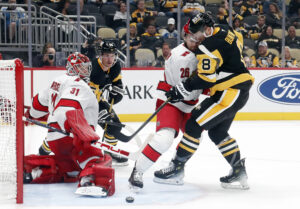The future of Dustin Byfuglien in the National Hockey League remains unclear. Considering his absence all season, however, one might begin to ponder the status of his career. His Winnipeg Jets are in a desperate struggle for the final wildcard position. Without his services, they may reasonably miss the postseason for the first time since 2016-17. For nearly a decade, he has been one of Jets’ most vital contributors: a talented, remorseless presence whose strength and skill could obliterate opponents. He could terrorize his opposition, especially in the postseason. Last year, he scored eight points in six playoff games with the Jets. The year before that, he contributed 16 points in 17 postseason matches. As his team clings dearly to its playoff hopes, Byfuglien’s importance to their success has become clearer than ever.
The gargantuan defenceman has always been a star athlete. Since 2011, he has ranked in the Top 15 of Norris Trophy voting six times. He has achieved five 50-point seasons on defence and is, additionally, a six-time NHL All-Star. As of just last season, this 6’5”, 260-pound bogeyman towered above his opposition. His absence this year has been a relief to his usual on-ice foes.
Whenever Byfuglien is on the ice, no player is safe from being crumpled into the boards. When tasked with overpowering his opposition, he is capable of physically dominating as few players can. His most notable obstacle has never been any particular player — rather, it has always been his sense of complacency.
Dustin Byfuglien: Jets Power Forward Who Never Was
Brilliant, But Lazy
Dustin Byfuglien considers himself to be a natural defenceman despite also spending some time as a forward in junior. He was a well-known prospect during his days with the Western Hockey League’s Prince George Cougars. NHL scouts became quite aware of his raw talent before the Chicago Blackhawks drafted him in 2003. The value of his talent, nevertheless, was offset by his poor work ethic. He was grossly overweight, prompting caution among teams and executives. At the Blackhawks’ 2003 prospects camp, he registered a weight of 268 pounds. From a conditioning perspective, he was undisciplined. Hence, he was drafted in the eighth round, 245th overall when his talent might have warranted an earlier selection.
At the NHL’s Central Scouting combine that year, several teams asked Cougars player Jonathan Filewich about his gifted-yet-inexplicable teammate:
“Everyone knows he’s really skilled, and when I was in Toronto a bunch of the teams asked me about him… They asked about his weight, and if he’s for real. I told them he was overweight but he has a lot of skill. If Dustin wants to play in the NHL, he will. No team is really sure about him, that’s what I think. Someone will draft him, and someone might even panic and take him early because they think he won’t be around for that long.” – Jonathan Filewich, WHL teammate of Dustin Byfuglien, July 2003 (Jim Swanson, Prince George Citizen, 20 June 2003)
Not Enough Effort
Byfuglien’s nonchalant approach extended to numerous facets of his world. In 2009, he asserted that he played youth hockey simply because he wished to participate in the same activities as the other children in Minnesota. He also admitted that he, regrettably, “just wasn’t into school. I hated it, didn’t see a need for it… I wouldn’t participate or give an effort. Nothing.” The ambition was absent. Fortunately, a WHL scout identified him at the age of sixteen, charting a course for his eventual NHL career.
Struggles With Fitness and Conditioning
His tendency to conserve effort was never exorcised from his identity. There have been several moments of frustration over the past decade as a result of this characteristic. Not long before the 2009 playoffs, he believed that “it was pointless to [body check] all the time.” This sense of disinterest has resurfaced at various intervals throughout his career. It has been a hindrance throughout Byfuglien’s time as a professional.
Fitness concerns have also been a recurrence. Critics lambasted him in 2011 for weighing 286 pounds, 20 pounds above his playing weight, at the start of that year’s Jets training camp. The following year, he infamously appeared in a wedding photograph sporting an unacceptably rotund figure. In 2013, his poor fitness habits endured throughout the Jets’ season, and he allegedly weighed 302 pounds at that campaign’s conclusion.
Notwithstanding his shortcomings, Dustin Byfuglien can regularly facilitate his team’s on-ice success, and during his prime years could sometimes win games single-handedly. He has been disparaged at times for his unwillingness to elevate his intensity. He has, however, offered enough on most nights to be considered an irreplaceable contributor. Furthermore, his positional flexibility remains rare among NHL players.
A Glimpse of Power Forward Greatness
The defence is his vocation, but his most famous and illustrious performance was in a temporary role as a forward. As early as his time with the Prince George Cougars of the WHL, Dustin Byfuglien was prone to comparisons with Todd Bertuzzi whenever he played forward (Jim Swanson, Prince George Citizen, 2003 March 16). One may argue that his brief period as a winger with the Chicago Blackhawks was the peak of his career. The Blackhawks could not retain his services, however. Salary cap concerns resulted in a consequent blockbuster exchange with the Atlanta Thrashers.
Versatility and Flexibility in Multiple Roles
Upon Byfuglien’s arrival in Atlanta, he became a key member of their defence unit. This was an unexpected turn of events. His displays of ability at forward were exceptional. Woefully, he allegedly lacked interest in consistently exerting himself to the degree required for the role. His apathy prevented him from possibly becoming an elite, heavyweight power forward icon a la Eric Lindros and Todd Bertuzzi. Dustin Byfuglien, 25 years old at the time, was hockey’s newest colossus.
Most spectators felt that the Atlanta Thrashers would receive a massive net-front upgrade akin to what they had seen in Chicago. The Thrashers’ general manager Rick Dudley referred to him as “probably one of the premier power forwards in the league.” Instead of becoming a mighty forechecker, however, he provided Norris Trophy-caliber defence for his new team. Later, Dudley declared that he felt that Byfuglien possessed as much potential at defence as at forward, an observation dating back to his time with the Blackhawks’ management group.
Byfuglien is an enigma, but his drawbacks did not halt his progression into one of the league’s most outstanding defencemen. One could argue that his reluctant personality inhibited some of his greatest abilities. Regardless, his skill and intelligence remained evident in his performances.
As a defenceman, he has been more stylistically similar to a rover than a conventional blue-liner. A rover does not conform to the positional standards of any position but rather moves into all areas of the ice to support their team’s puck possession. Byfuglien is a player of this nature.
An Elite Defenceman
For nearly a decade, Byfuglien has been one of the NHL’s leading scorers among defencemen. Between 2010-11 and 2018-19, his most recent eight years on defence, he accumulated 122 goals and 416 points. This ranks fourth among all NHL defenceman in goals and points during that span.
If not for an aversion to short, high-intensity bursts of effort and a high-energy work ethic required to remain at forward, he may very well have become the ideal prototype and role model for all aspiring power forwards of his era. Instead, he has been Atlanta and Winnipeg’s superstar defenceman — a cruiser and a bruiser.
The Payoff of Experimentation at Wing
As a member of the Chicago Blackhawks, Dustin Byfuglien initially played defence. In early 2008, however, head coach Denis Savard began to transition the young, multi-dimensional prospect to forward. Savard assigned Byfuglien to a line that featured rookie Patrick Kane and veteran Robert Lang. Against the Edmonton Oilers on February 6, 2008, he registered 11 shots on goal as a member of this trio. Analysts began to notice his magnificent potential. (Jim Matheson, Edmonton Journal, 7 Feb 2008). This successful trial at forward during the 2007-08 campaign elicited further attempts to unearth this other side of Byfuglien.
The experiment proved, once more, to be remarkably successful the following season. When the Blackhawks in 2009, under new coach Joel Quenneville, qualified for their first postseason campaign since 2002, Byfuglien was once more converted to forward. The team had just unlocked one of the keys to an impending championship campaign.
The newly-adopted power forward petrified his postseason opposition and, in particular, rattled the second-round opponent Vancouver Canucks with his destructive presence in the crease. Roberto Luongo and the Canucks’ defence were at the mercy of his immense, Herculean feats of strength. Canucks supporters were speechless as he played a massive role in the decimation of their playoff aspirations. Despite not scoring regularly for the Blackhawks in their 2009 postseason run, he was a monstrous force for his team. His pursuit of mayhem in the crease and the corners of the rink could seldomly be contained.
An Iconic, Championship-Calibre Performance
Byfuglien’s evolution as a forward became a crucial development for the Chicago Blackhawks in 2010. He struggled to score at times during the 2009-10 season and spent some games on defence due to an injury to Brian Campbell. However, his return to the wing in the playoffs proved to be critical to their success that spring. In 22 playoff games that year, he scored 11 goals and 16 points. Moreover, he scored a hat trick in Game Three against Vancouver, tallied a goal in every Western Conference Final game against the San Jose Sharks, and collected four points in Game Five of the Stanley Cup Finals against the Philadelphia Flyers.
Dustin Byfuglien was monumental in that year’s playoff run for Chicago. He had become a workhorse — or, perhaps, a tank — whose dominance evoked memories of a prime-era Todd Bertuzzi.
His performance in the 2010 Stanley Cup Finals is the basis of our video presentation today. His four-point, nine-hit offering in Game Five encapsulates everything about Byfuglien at his peak as a power forward. During that series, the Flyers often matched him against their most sinister defenceman. His main adversary was the nasty, ruthless, highly-decorated, legendary, 6’6”, 220-pound Chris Pronger.
Byfuglien vs Pronger
The two giants ruthlessly jostled in front of the Philadelphia crease. They poked and shoved one another, traded booming, violent body checks, and clashed explosively along the boards. Pronger was a former Hart and Norris Trophy winner playing in his third Stanley Cup Finals series in five seasons. He was a dependable, malevolent veteran who understood the level of intensity that the occasion demanded. With nearly two decades of experience and a career worthy of his induction into the Hockey Hall of Fame in 2015, Pronger recognized the amount of freedom he possessed in the Final to harm his opponent.
Through the first four games of the series, the wily veteran succeeded in stifling the effects of the newcomer.
Still, Byfuglien ultimately prevailed, improving with each additional round of experience. By the end of the series, Pronger faced punishing body checks that only a 260-pound wrecking ball could inflict. Rarely was the soon-to-be Hall of Famer forced to tolerate this level of resistance.
Byfuglien’s Game 5 performance secured a 3-2 series lead for the Chicago Blackhawks, setting the stage for the team’s Game 6 championship-clinching evening in Philadelphia. To place a dagger in the hearts of the Flyers, he scored the opening goal of the series’ finale at Wells Fargo Center. After the campaign, Byfuglien led all of that year’s playoff participants with five game-winning goals. The magnitude of his efforts even earned Byfuglien a small degree of unofficial support for the Conn Smythe Trophy. The overwhelming favourite for the trophy, however, was Blackhawks captain Jonathan Toews.
Intelligent and Gifted
Dustin Byfuglien has proven throughout his career that he can play both defence and forward at an elite level. He possesses a strong grasp of the positional expectations of both roles. As a winger, he has been responsible in his zone, returning to support his defence. Any opposing puck carrier within his reach must withstand his wrath. His uncanny ability to reduce the angle of his opponent and then painfully drive them into the boards is a significant aspect of his style of play, both at forward and on defence.
During his time at forward with Chicago, he provided numerous examples of commendable defensive coverage. His experience on the defensive side of the puck contributed to his overall play as a winger. He could strip the opponent of the puck and then assist with his team’s breakout. Smart head-man passes to his open linemates regularly led to offensive rushes. Alternatively, the Blackhawks’ defencemen could rifle the puck along the boards with Byfuglien in pursuit. He would bulldoze any opposing traffic in his path, gaining possession of the puck through force and anticipation. He was excellent in the corners of the ice, marvellously shielding the puck with his giant frame and supercharged motor.
Not only is Dustin Byfuglien powerful, though. He is also particularly mobile for his size. Additionally, he possesses a dangerous shot, anticipates plays well, and is immovable from his location on the ice. As of 2018-19, he was still very effective for the Winnipeg Jets. If he returns in 2020-21, one must hope that his skill set has not deteriorated too much.
Questions About Inconsistency
There are occasions when his defensive gaffes and inconsistent efforts have incensed his team’s supporters. A lack of focus from this casual spirit is a probable culprit. His struggle for motivation has been one of his most notorious hurdles. His most lethargic moments have often been the antithesis of his most inspired performances.
He is not the first player in the NHL’s history to baffle coaches with highly-variable play. In 1994, Alexander Mogilny, another famous enigma with exceptional talent, enlightened the hockey world about his controversial mindset:
“Well, I’ve always been a little different or something… It’s probably why I always had problems with my coaches. Because I don’t like it when somebody tells me something. What to do and stuff like that… If I think it’s wrong, I try to do it my own way. If I disagree with something, I like to say it.” – Alexander Mogilny, Buffalo Sabres forward, February 1993
Byfuglien, meanwhile, expressed his positional preferences in 2011.
“I enjoy defence more than I enjoy forward… I want to establish myself as a defenseman… That’s what I always played coming up. I think I did a good job at forward in Chicago, but I think I can be the player on defence that I was at forward. I’d like to add that tool to my bag. I think I’ll fit in here very well on defence.” – Dustin Byfuglien, October 2010
Both players likely had more to offer than what they exhibited in the NHL.
Gone Too Soon
Byfuglien played a pivotal role in the Blackhawks’ first Stanley Cup Championship season since 1961. Mere days later, he was no longer a member of the Chicago Blackhawks. That group’s window of opportunity closed with the most ideal outcome. Spectators could now only imagine the effect of the league’s newest power forward on the bottom-dwelling Atlanta Thrashers.
His follow-up campaign stunned the hockey community. He immediately scored 20 goals and 53 points, new career highs, on defence. He also represented the team in that year’s All-Star Game and caused a commotion about his unexpected Norris Trophy candidacy. Byfuglien was arguably the new face of the Thrashers. Soon, he would become one of the leaders of the re-established Winnipeg Jets. This signalled the virtual end of his time as a high-tempo forward. It was the start of a decade-long career as an elite blue-liner.
Unfulfilled Potential
Several brief attempts to return Byfuglien to forward throughout the next decade were met with mixed results. Once he achieved an elite degree of success as a defenceman, his mind appeared to be set. It seemed that the laborious style of play required to contribute as a forward no longer interested him. His desire to conserve energy triumphed above his will to become the next Bertuzzi or Lindros. Byfuglien was too talented and intelligent not to succeed. Having not applied himself fully, however, a degree of mystery will always remain about this astonishing player’s true potential. Teams have expressed interest in his acquisition, but his return ultimately rests with his desire to continue playing.
Dustin Byfuglien’s long-term legacy will likely be that of an All-Star defenceman. As a member of the Winnipeg Jets, his mere presence intimidated all opposing attackers.
Some will, however, remember him as the great power forward who never was.
Kevin is @CambieKev on Twitter.
Main Photo:
Embed from Getty Images






